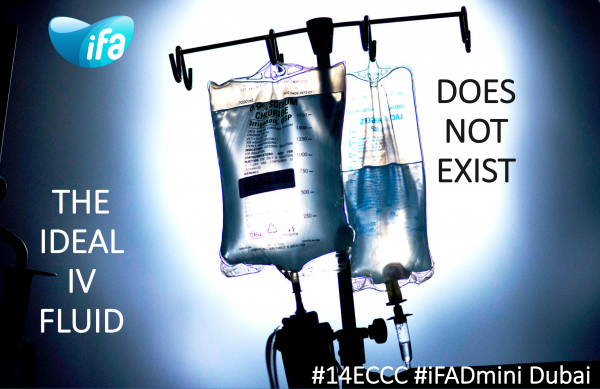
What is the ideal IV fluid? (#iFADmini #IFAD2018)
Can we engineer a superfluid to replace human plasma?
Take Home message on the ideal fluid (lecture by @Manu_Malbrain #14ECCC #iFADmini Dubai):
- The ideal IV fluid does not exist
- Different fluids have different (contra)indication during the different phases
- Resuscitation fluids should save lives: give them in appropriate dose and timing
- 4ml/kg/10 minutes and repeat
- Set your targets appropriately to reach your goals
- Targets and goals are dynamic and can change during different phases
- Maintenance fluids should cover daily needs
- for water: 1ml/kg/hr
- for glucose: 1 – 1.5 g/kg
- for Sodium (Na): 1 – 1.5 mEq/kg
- for Potassium (K): 0.5 – 1 mEq/kg
- Replacement fluids should the fluids that were lost
- Give saline or NH4Cl (multion gastrique) in case of GI losses
- Give blood when bleeding
- Fluids in sepsis and in general ICU patients
- Never use starches (little evidence for gelatins)
- Don’t use (abnormal) saline (NaCl 0.9%) or glucose 5% for resuscitation
- You can use saline to dilute drugs (max 1ml/kg/first week)
- Use (balanced) crystalloids for resuscitation
- Consider albumin 20%, esp. in very sick septic patients at later stage and during de-resuscitation
- Cover daily needs with…? Hypotonic solutions probably better than isotonic
- Fluids in perioperative setting (+ trauma)
- We can’t extrapolate from the big fluid trials and need dedicated studies, beyond fluid choice alone
- Starches still could have their place, but… we are awaiting final EMEA decision on PRAC recommendation
- In their dedicated setting: acute and proven hypovolemia
- With great care (maximum dose 30ml/kg, not in AKI or CKI, not in sepsis or burns)
- Gaps best to be filled by balanced crystalloids (not saline), little evidence for gelatins
- More emphasis on fluid strategy than on the fluid itself
- Implement Fluid Stewardship in your hospital and ICU
- Start with snapshot
- Check what you use (pharmacy)
- Perform survey on knowledge (doctors and nurses)
- Clinical audit (medical records and patient files)
- PDCA cycle
- Set-up guidance
- Start teaching
- Re-evaluation after 6 months
- Start with snapshot
- Link to Video on Vimeo: https://vimeo.com/263125026